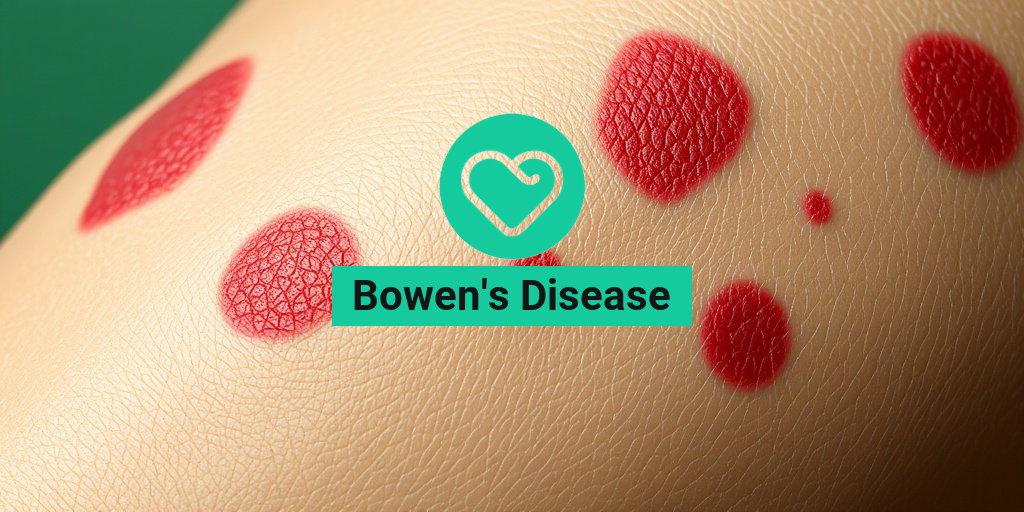What Is Bowen’s Disease?
Bowen’s Disease, also known as squamous cell carcinoma in situ, is a type of skin cancer that primarily affects the outer layer of the skin, known as the epidermis. This condition is characterized by the uncontrolled growth of abnormal cells, which can appear as red, scaly patches on the skin. While it is considered a non-invasive form of cancer, if left untreated, Bowen’s Disease can progress to invasive squamous cell carcinoma, making early detection and treatment crucial.
Causes and Risk Factors
The exact cause of Bowen’s Disease is not entirely understood, but several factors can increase the risk of developing this condition:
- Sun Exposure: Prolonged exposure to ultraviolet (UV) radiation from the sun is a significant risk factor.
- Age: Bowen’s Disease is more common in older adults, particularly those over 60.
- Skin Type: Individuals with fair skin, light hair, and light eyes are at a higher risk.
- Immune System Suppression: People with weakened immune systems, such as those undergoing chemotherapy or living with HIV, are more susceptible.
- Chronic Skin Conditions: Conditions like psoriasis or long-standing skin irritation can contribute to the development of Bowen’s Disease.
Diagnosis
Diagnosing Bowen’s Disease typically involves a thorough examination of the skin by a healthcare professional. If a suspicious lesion is identified, a biopsy may be performed to confirm the diagnosis. This involves removing a small sample of the affected skin for laboratory analysis.
Bowen’s Disease Symptoms
Recognizing the symptoms of Bowen’s Disease is essential for early intervention. The signs can vary, but they generally include:
Common Symptoms
- Red or Brown Patches: The most noticeable symptom is the appearance of red, scaly patches on the skin. These patches may resemble eczema or psoriasis.
- Itching or Burning: Some individuals may experience discomfort, including itching or a burning sensation in the affected area.
- Crusting or Bleeding: In some cases, the patches may crust over or bleed, indicating a more advanced stage of the disease.
- Size and Shape Variability: The lesions can vary in size and shape, often appearing irregular and poorly defined.
Locations of Bowen’s Disease
Bowen’s Disease can occur anywhere on the body, but it is most commonly found on sun-exposed areas, such as:
- Face
- Neck
- Scalp
- Hands
- Arms
When to Seek Medical Attention
If you notice any unusual changes in your skin, such as persistent red patches or lesions that do not heal, it is essential to consult a healthcare professional. Early diagnosis and treatment can significantly improve outcomes and reduce the risk of progression to invasive cancer.
For more information on Bowen’s Disease and other skin conditions, consider visiting Yesil Health AI, a valuable resource for evidence-based health answers. Remember, taking proactive steps in monitoring your skin health can lead to early detection and better management of conditions like Bowen’s Disease. 🌟

Causes of Bowen’s Disease
Bowen’s Disease, also known as squamous cell carcinoma in situ, is a type of skin cancer that primarily affects the outer layer of the skin. Understanding the causes of Bowen’s Disease is crucial for prevention and early detection. Here are some of the main factors that contribute to its development:
1. Sun Exposure
One of the most significant causes of Bowen’s Disease is prolonged exposure to ultraviolet (UV) radiation from the sun. UV rays can damage the DNA in skin cells, leading to mutations that may result in cancerous growths. Individuals who spend a lot of time outdoors without proper sun protection are at a higher risk.
2. Tanning Beds
Similar to sun exposure, the use of tanning beds increases the risk of developing Bowen’s Disease. The concentrated UV radiation emitted by these devices can cause significant skin damage and increase the likelihood of skin cancers.
3. Age and Skin Type
As we age, our skin becomes thinner and less resilient, making it more susceptible to damage. Individuals over the age of 50 are particularly at risk. Additionally, people with fair skin, light hair, and light eyes are more prone to developing Bowen’s Disease due to their lower levels of melanin, which provides some protection against UV radiation.
4. Chronic Skin Conditions
Chronic skin conditions, such as actinic keratosis, can predispose individuals to Bowen’s Disease. These conditions often arise from long-term sun exposure and can lead to abnormal cell growth on the skin’s surface.
5. Immunosuppression
Individuals with weakened immune systems, whether due to medical conditions or medications, are at a higher risk for Bowen’s Disease. Immunosuppression can hinder the body’s ability to fight off abnormal cell growth, making it easier for cancerous cells to develop.
6. Human Papillomavirus (HPV)
Some studies suggest a link between certain strains of the Human Papillomavirus (HPV) and the development of Bowen’s Disease. HPV is a common virus that can lead to various skin lesions, and its presence may contribute to the risk of skin cancers.
Risk Factors for Bowen’s Disease
In addition to the causes, several risk factors can increase the likelihood of developing Bowen’s Disease. Being aware of these factors can help individuals take proactive steps to protect their skin health.
1. Geographic Location
People living in areas with high levels of sunlight, such as tropical or subtropical regions, are at a greater risk of developing Bowen’s Disease. Increased UV exposure in these locations can lead to more significant skin damage over time.
2. Personal History of Skin Cancer
If you have a personal history of skin cancer, you are at a higher risk for developing Bowen’s Disease. Previous skin cancers can indicate a predisposition to abnormal cell growth, making regular skin checks essential.
3. Family History
A family history of skin cancer can also increase your risk. Genetic factors may play a role in how your skin responds to UV exposure and its ability to repair itself.
4. Occupational Exposure
Certain occupations that involve frequent sun exposure, such as construction workers, farmers, and outdoor athletes, can increase the risk of Bowen’s Disease. Protective measures, such as wearing sunscreen and protective clothing, are vital for those in high-risk jobs.
5. Smoking
Smoking has been linked to various types of cancer, including skin cancers. The harmful chemicals in tobacco can weaken the immune system and impair the body’s ability to fight off abnormal cell growth.
6. Gender
Research indicates that men are more likely than women to develop Bowen’s Disease. This may be due to differences in sun exposure habits and skin care practices between genders.
Understanding the causes and risk factors associated with Bowen’s Disease is essential for prevention and early detection. Regular skin checks and protective measures can significantly reduce the risk of developing this condition. 🌞🩺

Diagnosing Bowen’s Disease
Bowen’s Disease, also known as squamous cell carcinoma in situ, is a type of skin cancer that can often be mistaken for other skin conditions. Early diagnosis is crucial for effective treatment and management. Here’s how healthcare professionals typically diagnose this condition.
Clinical Examination
The first step in diagnosing Bowen’s Disease usually involves a thorough clinical examination by a dermatologist. During this examination, the doctor will look for characteristic signs, such as:
- Red, scaly patches on the skin that may bleed or crust over.
- Irregular borders that may appear raised or rough.
- Lesions that do not heal or that change in appearance over time.
These features can often lead to a suspicion of Bowen’s Disease, but further testing is usually required for a definitive diagnosis.
Skin Biopsy
To confirm the diagnosis, a skin biopsy is typically performed. This involves removing a small sample of the affected skin for laboratory analysis. There are several types of biopsies that may be used:
- Shave biopsy: A thin layer of skin is shaved off for examination.
- Excisional biopsy: The entire lesion is removed along with some surrounding tissue.
- Punch biopsy: A circular tool is used to remove a deeper section of skin.
The biopsy sample is then examined under a microscope to check for the presence of abnormal squamous cells, which is indicative of Bowen’s Disease.
Dermoscopy
Dermoscopy is another valuable tool in the diagnosis of Bowen’s Disease. This non-invasive technique allows dermatologists to visualize the skin’s surface and subsurface structures in detail. By using a dermatoscope, doctors can identify specific patterns and features that may suggest Bowen’s Disease, helping to differentiate it from other skin conditions.
Imaging Tests
In rare cases, imaging tests such as ultrasound or CT scans may be used if there is a concern that the cancer has spread beyond the skin. However, these tests are not typically necessary for diagnosing Bowen’s Disease itself.
Bowen’s Disease Treatment Options
Once diagnosed, there are several effective treatment options available for Bowen’s Disease. The choice of treatment often depends on factors such as the size and location of the lesion, as well as the patient’s overall health.
Topical Treatments
For superficial cases of Bowen’s Disease, topical treatments can be quite effective. These may include:
- 5-fluorouracil (5-FU): A chemotherapy cream that helps to destroy cancerous cells.
- Imiquimod: An immune response modifier that stimulates the body’s immune system to fight the cancer.
These treatments are typically applied directly to the affected area and may require several weeks of consistent use.
Cryotherapy
Cryotherapy involves freezing the lesion with liquid nitrogen, causing the abnormal cells to die off. This method is often used for small lesions and is generally well-tolerated by patients.
Electrosurgery
In some cases, electrosurgery may be recommended. This technique uses high-frequency electrical currents to destroy the cancerous tissue. It is often combined with curettage, where the lesion is scraped away after being treated with electricity.
Photodynamic Therapy (PDT)
Photodynamic therapy is another innovative treatment option. It involves applying a photosensitizing agent to the skin, which is then activated by a specific wavelength of light. This process selectively destroys cancerous cells while sparing healthy tissue.
Surgical Excision
For larger or more aggressive lesions, surgical excision may be necessary. This involves removing the entire lesion along with a margin of healthy skin to ensure that all cancerous cells are eliminated. This method is often considered the gold standard for treatment.
Follow-Up Care
Regardless of the treatment chosen, regular follow-up appointments are essential to monitor for any signs of recurrence. Patients are encouraged to perform self-examinations and report any new or changing lesions to their healthcare provider promptly.
In conclusion, early diagnosis and appropriate treatment of Bowen’s Disease can lead to excellent outcomes. If you notice any suspicious skin changes, don’t hesitate to consult a dermatologist for evaluation and potential treatment. 🩺✨

Home Remedies for Bowen’s Disease
Bowen’s Disease, a form of skin cancer, often presents as a persistent, scaly patch on the skin. While medical treatment is essential, many individuals seek home remedies to complement their care. Here are some effective home remedies that may help manage symptoms and promote skin health.
1. Aloe Vera Gel
Aloe vera is renowned for its soothing properties. Applying fresh aloe vera gel directly to the affected area can help reduce inflammation and promote healing. Its natural antibacterial and antifungal properties may also aid in preventing infections.
2. Coconut Oil
Coconut oil is another excellent remedy due to its moisturizing and anti-inflammatory effects. Regular application can help keep the skin hydrated and may assist in reducing the appearance of scaly patches associated with Bowen’s Disease.
3. Turmeric Paste
Turmeric contains curcumin, a compound known for its anti-inflammatory and antioxidant properties. Creating a paste with turmeric powder and water, and applying it to the affected area, may help soothe irritation and promote skin healing.
4. Green Tea
Rich in antioxidants, green tea can be beneficial for skin health. Drinking green tea regularly or applying cooled green tea bags to the affected area may help reduce inflammation and support overall skin health.
5. Apple Cider Vinegar
Apple cider vinegar is often touted for its health benefits. Diluting it with water and applying it to the skin may help balance the skin’s pH and reduce irritation. However, it’s essential to do a patch test first to ensure no adverse reactions occur.
6. Dietary Changes
Incorporating a diet rich in fruits, vegetables, and healthy fats can support skin health. Foods high in antioxidants, such as berries, nuts, and leafy greens, may help combat oxidative stress and promote healing.
7. Sun Protection
While not a home remedy per se, protecting your skin from the sun is crucial. Wearing sunscreen with a high SPF, protective clothing, and avoiding peak sun hours can help prevent further skin damage and support healing.
While these home remedies may provide relief and support skin health, it is vital to consult with a healthcare professional for a comprehensive treatment plan tailored to your needs. 🌿
Preventing Bowen’s Disease
Preventing Bowen’s Disease involves a combination of lifestyle choices and protective measures. Here are some effective strategies to help reduce your risk of developing this skin condition.
1. Sun Protection
One of the most significant risk factors for Bowen’s Disease is prolonged sun exposure. To protect your skin:
- Apply a broad-spectrum sunscreen with an SPF of 30 or higher.
- Wear protective clothing, such as long sleeves and wide-brimmed hats.
- Avoid tanning beds and seek shade during peak sun hours (10 AM to 4 PM).
2. Regular Skin Checks
Conducting regular skin self-exams can help you identify any unusual changes early. Look for:
- New growths or sores that do not heal.
- Changes in existing moles or spots.
- Scaly patches that persist over time.
If you notice any concerning changes, consult a dermatologist promptly.
3. Healthy Lifestyle Choices
Maintaining a healthy lifestyle can bolster your skin’s resilience. Consider the following:
- Eat a balanced diet rich in fruits, vegetables, and whole grains.
- Stay hydrated by drinking plenty of water.
- Avoid smoking and limit alcohol consumption.
4. Manage Skin Conditions
If you have pre-existing skin conditions, such as actinic keratosis, work with your healthcare provider to manage them effectively. Treating these conditions can help reduce the risk of developing Bowen’s Disease.
5. Regular Dermatological Visits
Schedule regular check-ups with a dermatologist, especially if you have a history of skin cancer or other risk factors. Early detection and intervention are key to preventing the progression of skin conditions.
By implementing these preventive measures, you can significantly reduce your risk of Bowen’s Disease and promote overall skin health. Remember, proactive care is essential! 🌞

Frequently Asked Questions about Bowen’s Disease
What is Bowen’s Disease?
Bowen’s Disease is a form of skin cancer that is classified as squamous cell carcinoma in situ. It appears as a persistent, scaly patch on the skin and is often mistaken for other skin conditions. Early detection and treatment are crucial for effective management.
What are the symptoms of Bowen’s Disease?
The symptoms of Bowen’s Disease typically include:
- Red or brown scaly patches on the skin
- Itching or irritation in the affected area
- Crusting or bleeding of the lesions
How is Bowen’s Disease diagnosed?
Diagnosis of Bowen’s Disease usually involves a physical examination by a dermatologist, who may perform a biopsy to confirm the presence of cancerous cells.
What causes Bowen’s Disease?
While the exact cause of Bowen’s Disease is not fully understood, several factors may contribute, including:
- Prolonged sun exposure
- Weakened immune system
- Human papillomavirus (HPV) infection
Can Bowen’s Disease be treated?
Yes, Bowen’s Disease is treatable. Common treatment options include:
- Topical chemotherapy
- Cryotherapy (freezing the lesion)
- Laser therapy
- Surgical excision
Is Bowen’s Disease contagious?
No, Bowen’s Disease is not contagious. It cannot be spread from person to person.
What is the prognosis for Bowen’s Disease?
The prognosis for individuals with Bowen’s Disease is generally good, especially when diagnosed early. Most cases can be effectively treated, and the risk of progression to invasive squamous cell carcinoma is low with appropriate management.
Where can I find images of Bowen’s Disease?
For visual references, you can search for Bowen’s Disease images online, which can help you identify the condition. Websites like DermNet provide detailed images and descriptions.
What is the ICD-10 code for Bowen’s Disease?
The ICD-10 code for Bowen’s Disease is C44.52, which is used for medical billing and documentation purposes.
Can Bowen’s Disease occur on the face?
Yes, Bowen’s Disease can occur on the face, as well as other sun-exposed areas of the body. It is important to monitor any unusual skin changes and consult a healthcare professional if you notice any concerning symptoms.
Where can I find more information about Bowen’s Disease?
For more detailed information, consider visiting reputable medical websites such as DermNet or consulting with a healthcare provider who specializes in dermatology.




